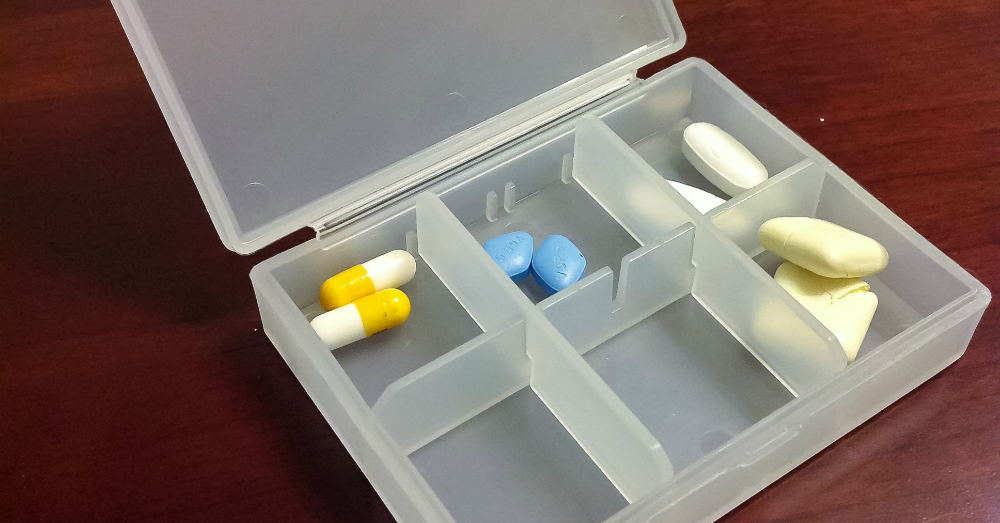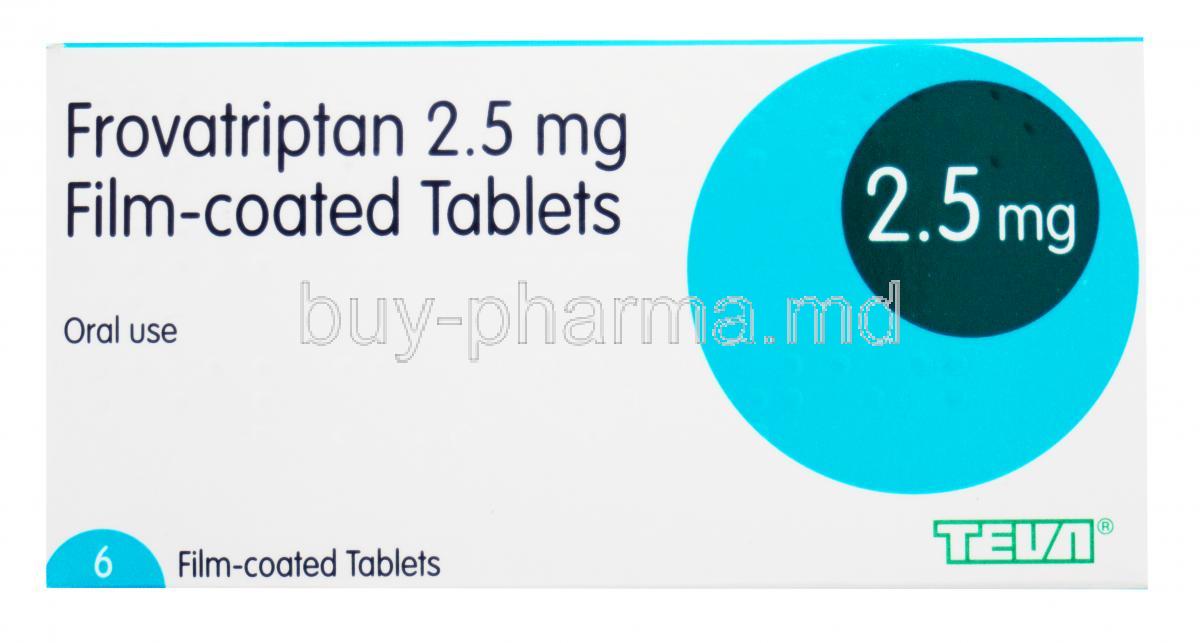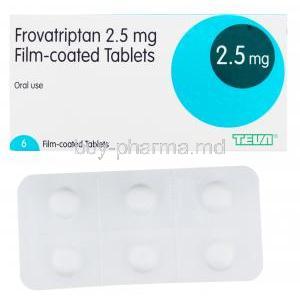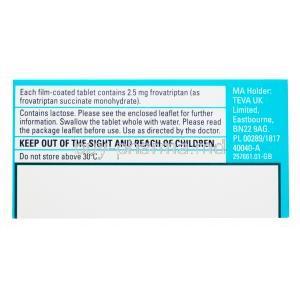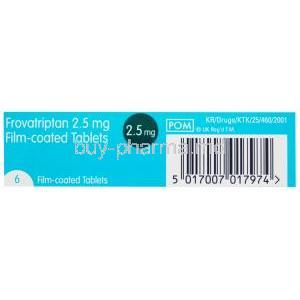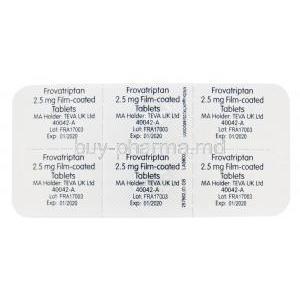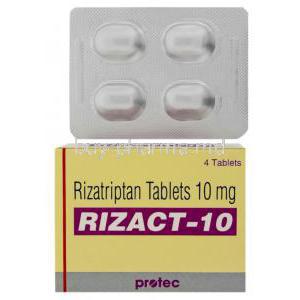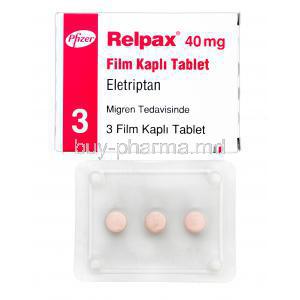Frovatriptan
- I. Introduction
- II. Composition of Frovatriptan
- III. Mechanism of Action: How Frovatriptan Works
- IV. Uses of Frovatriptan
- V. Off-Label Use of Frovatriptan
- VI. Dosage and Administration
- VII. Side Effects of Frovatriptan
- VIII. Important Precautions and Warnings
- IX. Special Considerations in Administration
- X. Handling Overdosage and Emergencies
- XI. Storage and Handling Precautions
I. Introduction
A. Introduction to Frovatriptan. Frovatriptan, a known member of the triptan class, is highly regarded for its ability to relieve migraines effectively. Its distinct molecular structure and pharmacokinetic properties set it apart from medications used for migraines.
B. Historical. Fda Approval. The journey of Frovatriptan from its inception to receiving approval from the FDA showcases the advancements in pharmaceutical development. It underwent clinical trials to ensure its safety and effectiveness before being approved in early 2001.
C.. Scope of the Article. This article aims to comprehensively analyze Frovatriptan by exploring its composition, mechanism of action, and various applications. Its purpose is to inform healthcare professionals and patients about its benefits and limitations.
II. Composition of Frovatriptan
A. The main ingredient in Frovatriptan is succinate, which acts as a potent serotonin (5 HT) receptor activator. This critical component plays a role in reducing the physiological processes involved in migraines.
B. Besides the ingredient, Frovatriptan also contains several other substances that help maintain the stability and effectiveness of the drug. These additional components include lactose monohydrate, microcrystalline cellulose, and magnesium stearate.
C. Regarding its classification, Frovatriptan falls under the category of selective 5 HT1B/1D receptor agonists. It is specifically designed to target and alleviate migraine symptoms without causing systemic effects like nonspecific medications often do.

III. Mechanism of Action: How Frovatriptan Works
A. Pharmacodynamics. Frovatriptan works by activating the 5 HT1B/1D receptors, which helps constrict the blood vessels inside the head. This constriction plays a role in the development of migraines.
B. Impact on Serotonin Levels. By regulating levels in the brain, Frovatriptan reduces the expansion of blood vessels that occur during migraine attacks, providing relief from symptoms.
C. Effect on Cerebral Blood Vessels. In addition to causing vasoconstriction, Frovatriptan also prevents the release of inflammatory neuropeptides, thereby reducing pain transmission within the central nervous system.
IV. Uses of Frovatriptan
Frovatriptan is a prescription medicine that is primarily used to treat migraine headaches 123. It helps to relieve headache, pain, and other migraine symptoms (including nausea, vomiting, sensitivity to light/sound) 2. Frovatriptan is a 5-HT1B/1D receptor agonist that narrows blood vessels around the brain and reduces substances in the body that can trigger headache pain, nausea, sensitivity to light and sound, and other migraine symptoms 1.
V. Off-Label Use of Frovatriptan
A. Treating Cluster Headaches Potential. Although primarily used for migraines, there is promising evidence that Frovatriptan could be effective in relieving cluster headaches. This use is not official. Supported by emerging clinical data.
B. Managing Menstrual Migraines. Frovatriptan has shown efficacy in treating migraines, which are a specific subtype of migraines. This makes it a viable option for women who experience induced migraines.
C. Ongoing Research and Case Studies. Researchers are continuously conducting studies and gathering anecdotal evidence to explore the broader applications of Frovatriptan in various headache disorders.
VI. Dosage and Administration
A. Recommended Dosage Instructions. It is suggested to start with a dose of 2.5 mg of frovatriptan as soon as the symptoms of migraine appear. If the headache returns a second dose can be taken,. It's essential to be mindful of the maximum daily dosage.
B. Adjusting Dosage for Specific Groups. Patients with liver or kidney problems should consider adjusting their dosage. Sometimes, a lower dose or more extended interval between doses may be necessary.
C. How to Take Frovatriptan. Frovatriptan is available in tablet form. It should be taken orally. It's best to swallow the tablet whole with water. You don't need to take it with food.
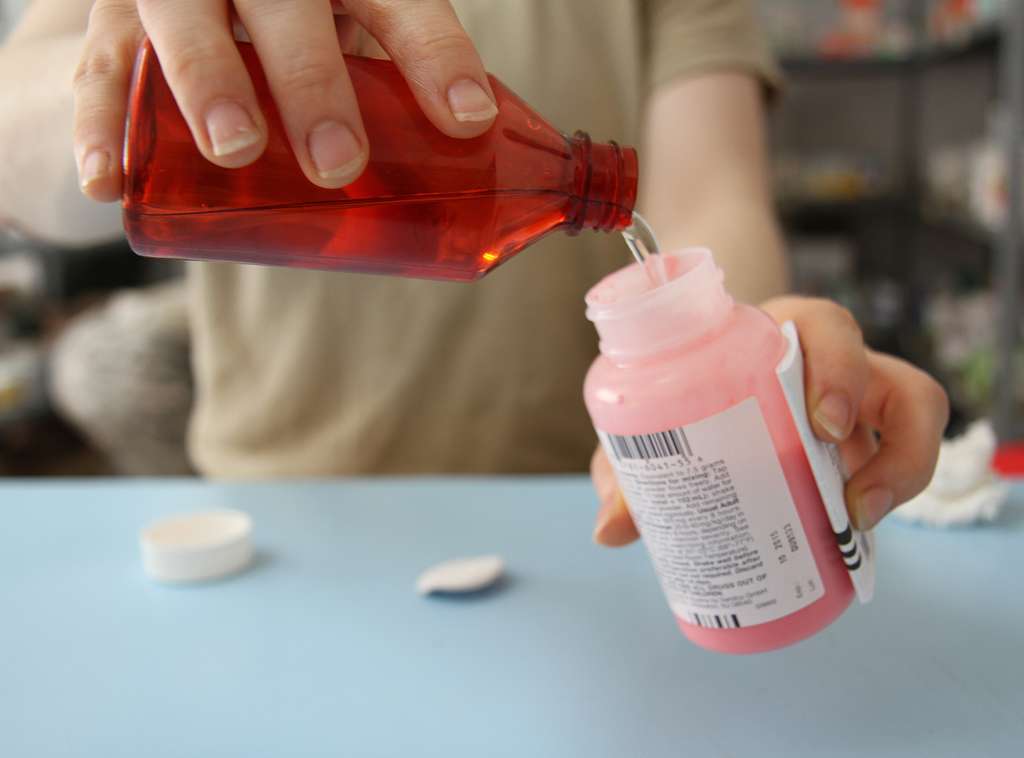
VII. Side Effects of Frovatriptan
A. Common Side Effects. The commonly reported side effects include dizziness, tiredness, tingling sensations, and a dry mouth. These effects are generally temporary and not severe.
B. Rare but Serious Adverse Reactions. Although they don't often happen, severe reactions like heart-related issues, stroke-like events, and allergic reactions have been recorded.
C. Long-Term Side Effects and Risks. More research is needed to understand the long-term safety of Frovatriptan, especially regarding cardiovascular risks, in individuals who are already predisposed to such issues.
VIII. Important Precautions and Warnings
A. Frovatriptan should not be used by patients who have a history of stroke transient attacks or significant heart disease.
B. If you are taking serotonin reuptake inhibitors (SSRIs) or serotonin norepinephrine reuptake inhibitors (SNRIs) be cautious when using Frovatriptan as there is a risk of serotonin syndrome.
C. If you have comorbid conditions, like hypertension or epilepsy, it is advisable to consult your healthcare provider before using Frovatriptan.
IX. Special Considerations in Administration
A. Administering to Patients. Older patients may need careful monitoring due to the risk of adverse reactions and coexisting health conditions.
B. Usage in Pregnant Women and Breastfeeding Mothers. The safety of Frovatriptan for women and breastfeeding mothers is not well established. Therefore, it's advisable to exercise caution when considering its use in these populations.
C. Use in Children; Safety and Effectiveness. The safety and effectiveness of Frovatriptan in patients have not been thoroughly evaluated. As a result, it is not recommended for use in children.
X. Handling Overdosage and Emergencies
A. Signs of Taking Much. Taking an excessive amount of Frovatriptan can result in various symptoms, including extreme tiredness, irregular heartbeat, and, in severe cases, high or low blood pressure. Patients may also experience dizziness and confusion as part of symptoms.
B. Immediate Actions and Treatments. If someone overdoses on Frovatriptan, it's crucial to seek medical help. The main goal is to stabilize the patient's signs. If the ingestion was recent, gastric lavage might be considered. Unfortunately, there isn't an antidote for Frovatriptan, so treatment mainly focuses on providing support and addressing symptoms. It's important to monitor vital signs and offer supportive care to maintain cardiovascular and respiratory functions. In cases where patients come within 1 2 hours after ingestion activated charcoal may be administered to reduce absorption.
C. Managing Overdosage in the Long Run. Long-term management involves monitoring for any delayed effects. Providing appropriate support as needed. Regular checkups are essential to evaluate the patient's cardiovascular condition. Additionally, counseling may be recommended to address any issues that contributed to the overdose incident. Observing the individual for at least 24 hours following the event is advisable. It is important to consider health monitoring tools such as electrocardiogram (ECG) and blood pressure measurements. This is particularly crucial for patients who have existing heart conditions.
XI. Storage and Handling Precautions
A. Storing Frovatriptan; It is crucial to store Frovatriptan in conditions to maintain its effectiveness and safety. Keep the tablets at room temperature, avoiding exposure to heat and moisture. The recommended storage temperature is between 20°C and 25°C (68°F to 77°F).
B. Shelf. Expiry: Frovatriptan has a shelf life; using it after its expiration date can be ineffective or potentially harmful. Always check the expiry date before using the medication and discard any tablets that have passed this date. Also, refrain from using Frovatriptan if the packaging is torn or tampered with.
C. Safe Disposal Guidelines: Properly disposing of unused Frovatriptan is crucial to prevent accidental ingestion or environmental contamination. Do not dispose of the medication in household waste or sewage systems. Instead, consider utilizing take-back programs or consult a pharmacist for disposal methods. In case a take-back program is unavailable, mix the medication with an unappealing substance like dirt or cat litter, place it in a sealed container, and dispose of it in the trash.
